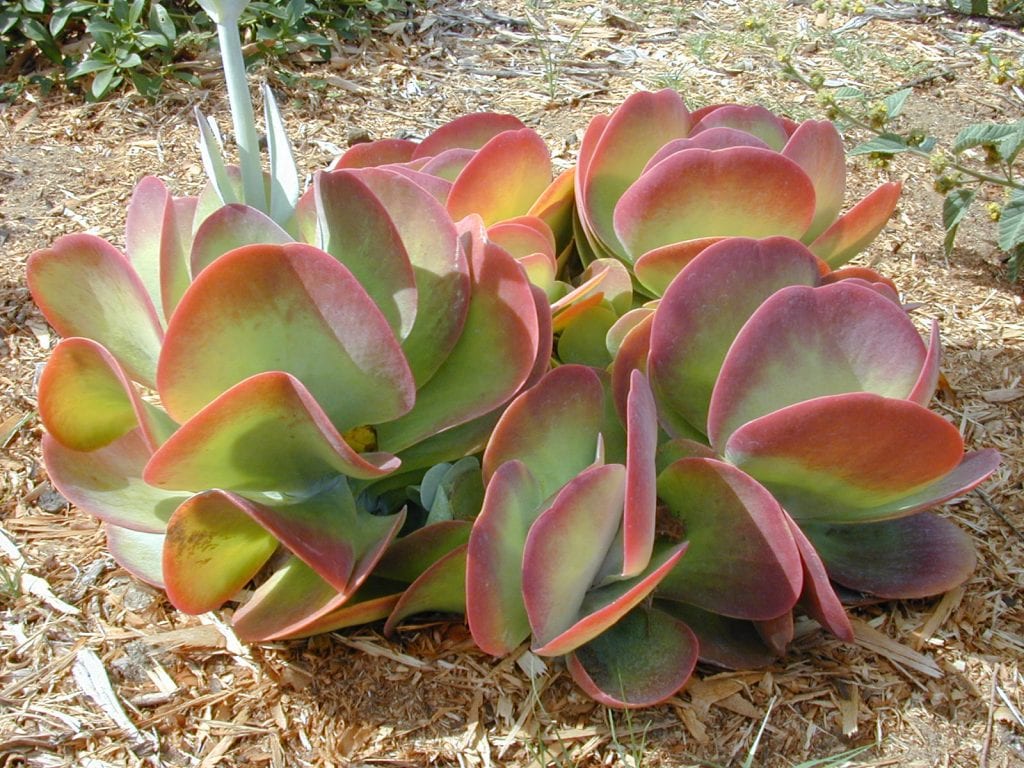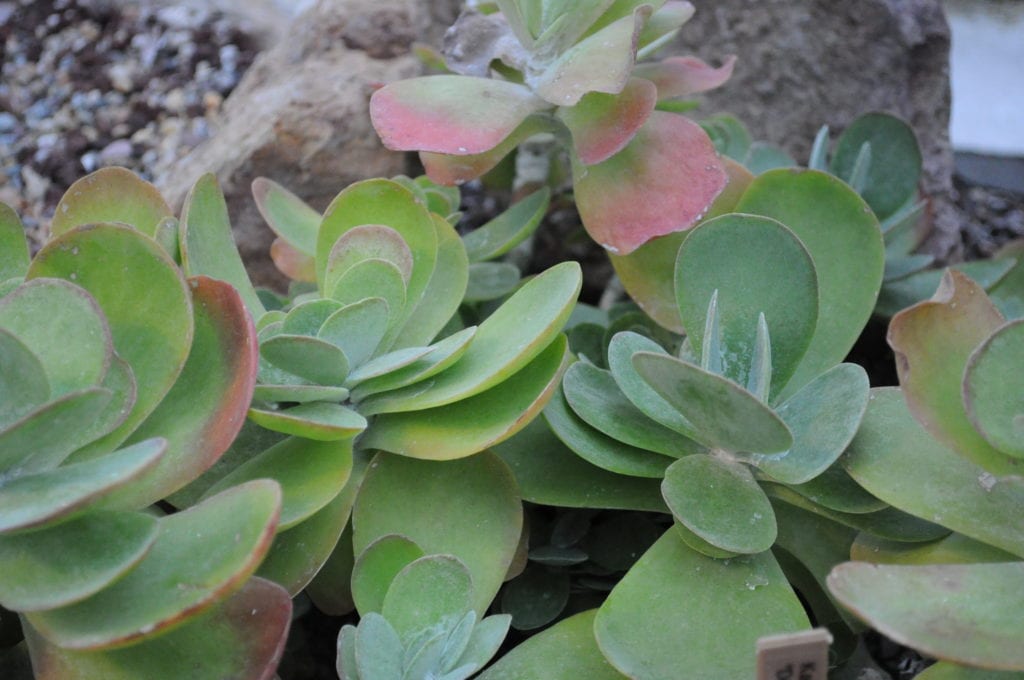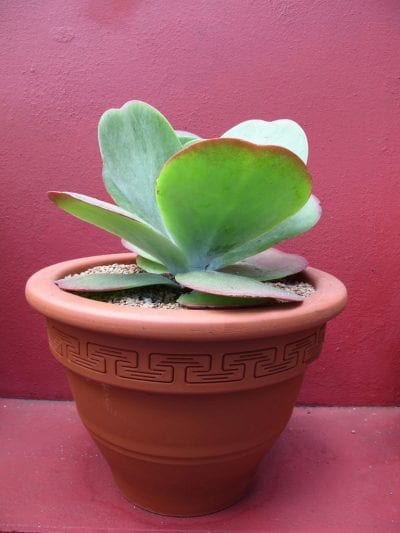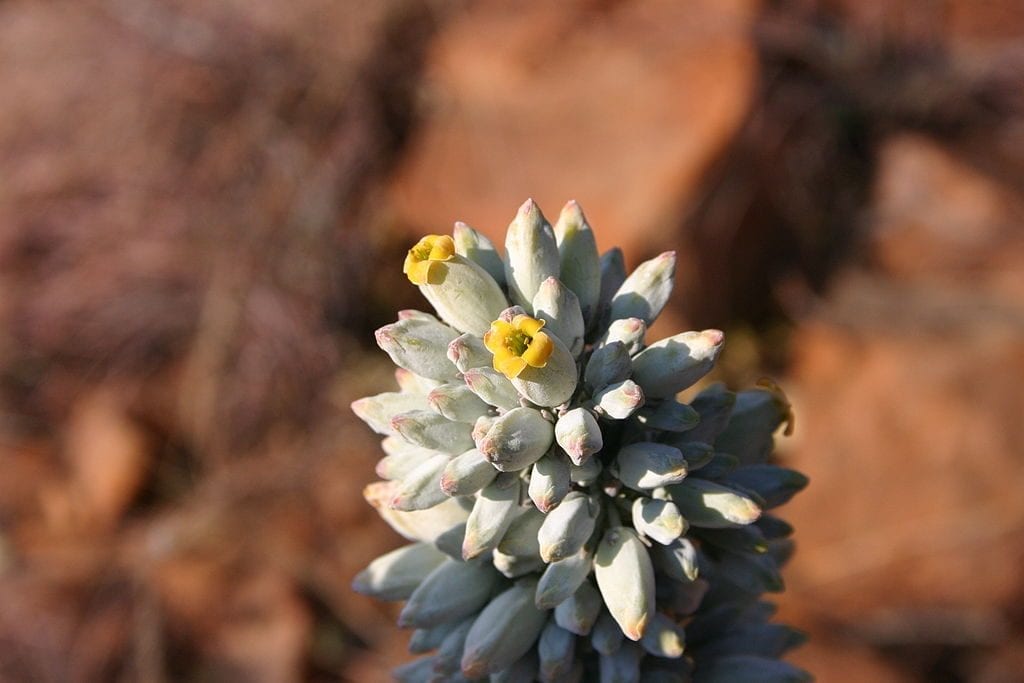
El Kalanchoe thyrsiflora it is a non-cactus succulent plant with great ornamental value. It is very, very easy to take care of, since it really only needs sun and little water so that you can contemplate it in all its splendor. In addition, it produces very beautiful flowers, something that does nothing more than make it a very interesting species for the garden or patio.
If you want to know both its characteristics and its care, then I'm going to tell you everything about him.
Origin and characteristics

Our protagonist is a non-cactaceous or crass succulent plant whose scientific name is Kalanchoe thyrsiflora which reaches 40-50cm in height. It is popularly called calanchoe or calanchoe tirsiflora. It is native to South Africa and Lesotho, and grows in a basal rosette with large, rounded and fleshy leaves, grayish-green in color and with a red margin. These are covered by a whitish fluff.
The inflorescence is erect and terminal, and gathers several waxy green flowers with yellow lobes. It blooms from fall to spring.
What are their cares?

If you want to have a copy, we recommend that you provide it with the following care:
Location
El Kalanchoe thyrsiflora it must be placed outside, in full sun. Interestingly, the more hours of direct light you have, the more pink / reddish your leaf margins will have.
It does not have invasive roots, but it can occupy a surface of 50cm long by more or less the same width since it has a tendency to take out suckers.
Irrigation
It is one of the Kalanchoe types that better resists drought, but not waterlogging. Therefore, it is advisable to check the humidity of the soil before watering. For this you can do any of these things:
- Introduce a thin wooden stick: or finger. When you remove it, if you see that a lot of soil has adhered, do not water, since it will remain wet.
- Dig about four inches around the plant: the humidity of the soil is not lost as quickly on the surface as in the inner layers, so to know how the soil is doing, it is advisable to dig a little around the plant. If you see that it has a dark brown color and when you touch it you feel fresh, do not water.
- Using a digital moisture meter: To be very effective, insert it closer to the succulent and again further away. As soon as you do it, you will see how wet the earth is.
- Weigh the pot once watered and again after a few daysBecause wet soil weighs more than dry soil, you will be able to know when it is time to water.
Even so, you should know that you have to water very little. During the hottest and driest season, 2 or a maximum of 3 waterings a week will suffice, while the rest of the year, once every 7 or 10 days will be enough. During winter, water every 15-20 days.
Earth

It can be both in a pot and in the garden:
- Flower pot: universal growing medium alone or mixed with 30% perlite.
- Garden: grows in all types of soils as long as they have good drainage. As it is not a plant that is excessively large, if you have a compact or poorly drained soil, make a hole of about 50cm x 50cm and mix the soil with perlite in equal parts.
Subscriber
Not that it is very necessary, but it is advisable to fertilize throughout the growing season, that is, throughout the warm season, with fertilizers for succulents following the indications specified on the product packaging. You can also use Nitrofoska azul, which is a fast-effective granular fertilizer. The dose of the latter is a small spoon (of the coffee ones) for very young specimens that are in pots of up to 10,5 cm in diameter, and two or three small tablespoons for the larger ones.
Multiplication
It multiplies by seeds and by suckers in spring or summer. Let's see how to proceed in each case:
Seeds
The step by step to follow is as follows:
- The first thing to do is fill a 10,5cm pot with universal growing medium and water.
- Then, a maximum of 2 or 3 seeds are placed on the surface and covered with a very thin layer of substrate.
- It is then watered with a sprayer.
- Finally, the pot is placed outside, in semi-shade.
If all goes well, they will germinate in 2-3 weeks.
Suckers
To multiply by Kalanchoe thyrsiflora by suckers you just have to select one that has an easily manipulated size, separate it from the mother plant, cut the stem that joins it with a hand saw, and then plant it in a pot of about 20cm in diameter with universal growing substrate. If you want you can, before putting it in the container, impregnate its base with homemade rooting agents, but it is not necessary.
Rusticity
Withstands cold and weak frosts of up to -2ºC. If you live in a colder area, you will need indoor protection.

What did you think of the Kalanchoe thyrsiflora? If you want to know more about Kalanchoe, Do click in the link.
I have a beautiful one and I was interested in knowing when to separate the children
Hello manuela.
You can separate the children in spring or summer, when they are about three-five centimeters tall.
Greetings.
I have one, when I bought it it had 10 leaves, after 3-4 weeks the lower two began to dry until I had to remove them, now one of the lower ones is starting to dry again and they have not come out new. What can I do to make new leaves come out?
Hello Daniel.
The Kalanchoe is a sunny and warm climate plant that wants little water.
If it is in shade and / or overwatered, it loses its leaves. To avoid this, you have to water little and place it either in the garden with light soil, or in a pot with holes in its base filled with volcanic sand (pumice, akadama) or fine gravel (1-3mm thick) mixed with 40% black peat.
I hope it gets better.
Regards!
Hello, I am consulting you to see if you can help me. I have 2 of these plants and now in spring the leaves have started to turn ugly. They dry from the tips down and brown spots appear on the leaves. In winter I was watering it every 2 weeks and now every 3 weeks. What I can do? Thanks
Hi Matias.
Are they in pots or on the ground? If they are in pots, have you ever changed them to a larger one? Is that if they always carry it, their roots run out of space and the plant begins to get ugly.
On the other hand, although it is unlikely, but it is advisable to look to see if they have any pests that could affect them. In this type of kalanchoe it is rare, but it does not hurt to check it. Perhaps there is an insect that is damaging them, and if so, cleaning with water and neutral soap would solve the problem.
Greetings.
Hello Natalia,
I just bought a precious kalanchoe thyrsiflora from a nursery in Elche, should I change the pot for a bigger one for spring, March or April?
I will change the substrate a little bit of peat moss, perlite, worm castings.
The irrigation as I check it now in winter every month putting a toothpick and see if there is humidity?
Thank you Merry Christmas ?
Hello Manuel.
We don't have any Natalia in the team hehe 🙂
I answer you, I am Monica, the blog coordinator.
Everything you say is correct, except the substrate. More than blond peat, black peat is better since the former has a low pH for this plant.
Irrigation will be sparse in winter, once a week or so. To make sure you can insert a thin stick: if when you take it out it comes out with a lot of adhered earth, it is still wet.
Greetings and merry christmas!
Hi! Of my succulents this is my favorite but one thing happens to me, it immediately grows and begins to gain slack at the base so it seems that it is going to fall because it does not hold well to the ground. It is as if it made a wide trunk that forces it to make more hole around it and even if I put substrate again after 2 or 3 weeks I already have the same problem again.
I have no idea why this happens since when transplanting it I even remove some leaf from below to put it deeper in the earth but the effect does not last long, not even 2 months.
If anyone knows why this is happening or has a solution, I would appreciate the advice.
Greetings,
Mercedes Martinez
Hello Mercedes.
Do you have it in the sun? It is that to grow well you need to give it directly for a minimum of 5 hours.
If it is in a pot, it may have become too small for you, and it will be necessary to plant it in a larger one.
You tell us. Greetings.